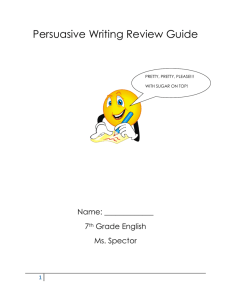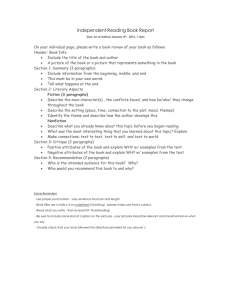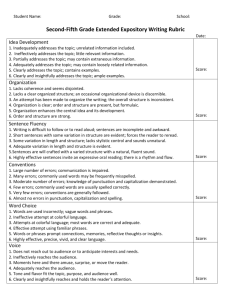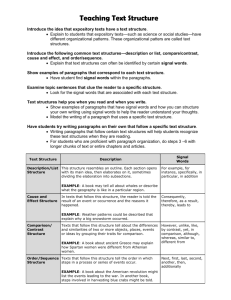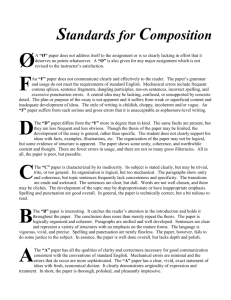Expository VS Persuasive TYPES OF WRITING
advertisement
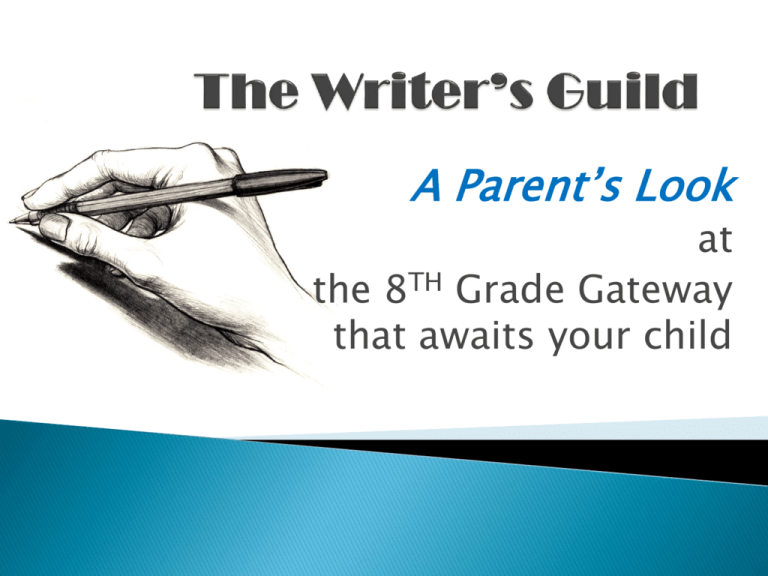
A Parent’s Look at the 8TH Grade Gateway that awaits your child 2 What is the Gateway Writing Test What is the difference between Expository and Persuasive writing? How have the students been prepared? What can parents do over the next two weeks? What are your parent concerns after tonight? Two types of writing Expository Persuasive For 8th grade students ONLY NO CHOICE in the style of writing 90 minutes – start to finish Follows the writing process Must pass the test for promotion Spring and/or Summer opportunity for retake if needed Remediation classes will be offered in the spring if needed Expository – INFORM – Writing I deas developed with explanations N eeds specific details and examples F ully develops the topic O rganizational strategy R eader‟s interest through strong voice M ulti-paragraph writing Writing to explain Factual True TELLING An (DOES writing writing – non-fiction or INFORMING the reader overall picture of the topic NOT try to persuade the reader) Multi-paragraph Fully develops idea with specific details and examples Blends personal experience and knowledge to inform the reader about the topic Single paragraph Repetitive, formulaic writing Encyclopedic coverage of facts or an abundance of facts unrelated to the topic Lively – catches the reader’s interest Engaging language and varied sentences Structured – introduction, development, and closure Correct sentences, grammar, and spelling Flat and uninteresting – not repetitive Imprecise language with no variety Not structured – no or weak introduction and/or conclusion, weak development of topic Incorrect sentences, grammar, and spelling (distracts reader) LEAD “HOW” LINE SHOW MEET – HIGHLIGHT 1 HIGHLIGHT 2 HIGHLIGHT 3 Or more ?? HOW MOMENT – MOST IMPORTANT CONCLUSION Persuasive – PERSUADE – Writing P osition E motional and/or logical appeal R eader engagement S pecific facts or personal experience U se precise language A nticipate audience concerns D efend your position E ffective arguments Writing True writing – non-fiction with OPINIONS PERSUADING Trying to convince the reader or CONVINCING the reader to win over the reader to do or believe Trying to persuade by urging or arguing Clear position on the issue Fully developed argument with details and examples Defending the position with relevant information Anticipating and countering audience position Specific facts/experiences/stats Appealing to logic and/or emotion Copying the prompt into the paper Repetitive, simple 5 paragraph format Irrelevant ideas that are inappropriate Unaware of audience position Facts/stories/anecdotes that are unrelated Just venting about a topic Organizational structure Multi-paragraph Engaging to the reader Precise language and varied sentences An introduction the issue, with fully developed position and closure Correct grammar/usage/spelling Ideas in illogical / confusing order Single paragraph Flat and uninteresting Imprecise language and little sentence variety Presenting idea with no development, support, or closure Lack of grammar, usage, or spelling (interferring with meaning) SHAKE (Greeting) SHOW TELL ROUND 1 ROUND 2 POW! MOMENT KNOCK BACK DO THIS, PLEASE SHAKE (Closing) “POW” LINE •Controlling idea •Supporting idea •Major details •Specific examples and elaboration •Supporting ideas (relevant) •Relevance of detail •Depth of development •Awareness of Genre •Overall Plan •Introduction/Body/Conclusion •Sequence of Ideas •Grouping of Ideas •Expository or Persuasive Strategies •Transitions •Word Choice •Audience Awareness •Voice •Sentence Variety •Strategies Appropriate to Expository or Persuasive Writing •SENTENCE FORMATION: correctness, clarity, simple, compound, complex, end punctuation •USAGE: sub-verb agreement, pronoun agreement, standard words •MECHANICS: internal punctuation, spelling, paragraphs, capitalization EXPOSITORY / INFORMATIONAL RUBRIC IDEAS (40%) -Controlling Idea -Supporting Ideas -Relevance of Details -Development Depth -Completeness -Awareness of Genre *Fully engages the reader by establishing a context, creating a speaker's voice, and otherwise developing reader interest. *Fully develops a controlling idea that conveys a perspective on a subject. *Fully includes appropriate facts and details. *Fully excludes extraneous details and inappropriate information. ORGANIZATION (20%) -Overall Plan -Intro/Body/Conclusion -Sequence of Ideas -Grouping of Ideas -Expository Strategies -Transitions *Organizing strategy is fully appropriate to the writer's topic and the assigned genre of writing. *Logical and appropriate sequencing and/or grouping of ideas within and across the paper. *Introduction engages and sets the stage and conclusion provides a sense of closure. *Uses effective and varied transitions to link all elements of the response (i.e. ideas, paragraphs, sentences, etc.) STYLE (20%) -Word Choice -Audience Awareness -Voice -Sentence Variety -Strategies Appropriate to Expository Writing *Carefully crafted sentences create sustained tone. *Varied, precise, and engaging language that is fully appropriate to the assigned genre. * Figurative, vivid, and/or technical language present. *Varied sentence lengths, structures, and beginnings. * Sustained attention to the audience. *Consistent voice that is sustained throughout response. *Variety of genre appropriate strategies engages reader CONVENTIONS (20%) -SENTENCE FORMATION: correctness, clarity, simple, compound, complex, end punctuation -USAGE: sub-verb agreement, pronoun agreement, standard words MECHANICS: internal punctuation, spelling, paragraphs, capitalization *Clear and correct simple, complex, and compound sentences with correct end punctuation. *Correct usage in a variety of contexts. *Correct mechanics in a variety of contexts. (See components listed in conventions domain.) *Infrequent, if any, errors *Errors do not interfere w/ meaning. IDEAS Fully developed ideas: 40 Consistent ideas: 35 Sufficient ideas: 30 Minimal ideas: 25 Lacks ideas: 20 ORGANIZATION Fully organized: 20 Consistent organization: 17 Sufficient organization: 15 Minimal organization: Lacks organization: 12 10 STYLE Fully developed style: 20 Consistent style: 17 Sufficient style: 15 Minimal style: Lacks style: 12 10 CONVENTIONS Full command: 20 Consistent command: 17 Sufficient command: 15 Minimal command: Lacks command: 12 10 PERSUASIVE RUBRIC DEAS (40%) -Controlling Idea -Supporting Ideas -Relevance of Details -Development Depth -Completeness -Awareness of Genre *Fully established position and fully developed that position with specific details. *Effectively and creatively uses appeals to logic and/or emotion ( i.e. specific facts, statistics, personal experience or knowledge, etc.) to support the writer's position. *Effectively and creatively introduces the reader to the issue and fully demonstrates an understanding of all aspects of the issue. ORGANIZATION (20%) -Overall Plan -Intro/Body/Conclusion -Sequence of Ideas -Grouping of Ideas -Persuasive Strategies -Transitions *Organizing strategy is fully appropriate to the writer's topic and the assigned genre of writing. *Logical and appropriate sequencing and/or grouping of ideas within and across the paper. *Introduction engages and sets the stage and conclusion provides a sense of closure. *Uses effective and varied transitions to link all elements of the response (i.e. ideas, paragraphs, sentences, etc.) STYLE (20%) -Word Choice -Audience Awareness -Voice -Sentence Variety -Strategies Appropriate to Persuasive Writing *Carefully crafted sentences create sustained tone. *Varied, precise, and engaging language that is fully appropriate to the assigned genre. * Figurative, vivid, and/or technical language present. *Varied sentence lengths, structures, and beginnings. * Sustained attention to the audience. *Consistent voice that is sustained throughout response. *Variety of genre appropriate strategies engages reader CONVENTIONS (20%) -SENTENCE FORMATION: correctness, clarity, simple, compound, complex, end punctuation -USAGE: sub-verb agreement, pronoun agreement, standard words MECHANICS: internal punctuation, spelling, paragraphs, capitalization *Clear and correct simple, complex, and compound sentences with correct end punctuation. *Correct usage in a variety of contexts. *Correct mechanics in a variety of contexts. (See components listed in conventions domain.) *Infrequent, if any, errors *Errors do not interfere w/ meaning. IDEAS Fully developed ideas: 40 Consistent ideas: 35 Sufficient ideas: 30 Minimal ideas: 25 Lacks ideas: 20 ORGANIZATION Fully organized: 20 Consistent organization: 17 Sufficient organization: 15 Minimal organization: Lacks organization: 12 10 STYLE Fully developed style: 20 Consistent style: 17 Sufficient style: 15 Minimal style: Lacks style: 12 10 CONVENTIONS Full command: 20 Consistent command: 17 Sufficient command: 15 Minimal command: Lacks command: 12 10 DOs to REMEMBER: DOs – that we DO stress that students DO … •DO write 2 PAGES – front and back – NO SKIPPING LINES – especially between paragraphs •DO know the style of writing and be sure to do it – Expository or Persuasive •DO remember the format for writing a letter •DO read the prompt more than once to understand the writing topic. •DO brainstorm •DO indent all paragraphs •DO make sure all paragraphs are at least 5 sentences •DO make sure writing is 5 or MORE paragraphs •DO write the final copy in BLUE or BLACK ink •DO proofread the final copy – use INSERT or SINGLE STRIKE THROUGH •DO write legibly.- print or cursive – your choice •DO include lots of detail •DO use transition words. •DO check the CRITERIA – -IDEAS* - DETAILS -ORGANIZATION – PARAGRAPHS – minimum of 5 paragraphs – intro., 3+ body, conclusion -STYLE – VOICE – aka CREATIVITY (adjectives / description) -CONVENTIONS – MECHANICS – spelling, punctuation, paragraphs •DO have a GOOD, STRONG Introduction •DO MAKE YOUR THESIS statement (main idea) – is your opinion of the topic – without saying “I….” •DO have a GOOD Conclusion •DO make sure the conclusion is DIFFERENT than the intro with a restatement of your opinion /thesis DON’Ts to REMEMBER: DON’Ts – that we DO stress that students NOT DO … •DON’T start a sentence with AND or BUT •DON’T repeat the same word over and over •DON’T use “I think…” “I hope you enjoyed…” “I am going to tell you…” •DON’T abbreviate •DON’T use etc. •DON’T use contractions •DON’T write numbers – INSTEAD spell out all numbers 1-100 •DON’T forget to indent all paragraphs – USE a paragraph sign at the beginning of paragraphs if you forget to indent •DON’T skip lines between paragraphs •DON’T write less than 5 paragraphs •DON’T write off topic •DON’T forget to READ the prompt more than once to understand the topic •DON’T use slang •DON’T introduce yourself … DON’T say “My name is…” •DON’T use the transitions – FIRST, SECOND, THIRD, LAST •DON’T say good bye in the conclusion •DON’T use “THE END” •DON’T use symbols (like 2 for the word “to”) •DON’T draw flowers, circles, or hearts to dot your “i.” Student Writing Checklist for Gateway Writing Prepare Yourself to Write •Read the Writing Situation and Directions for Writing carefully. •Brainstorm for ideas. •Decide what ideas to include and how to organize them. •Write only in English. Make Your Paper Meaningful •Use your knowledge and/or personal experiences that are related to the topic. •Explain, clarify, and define your ideas. •Establish a clear controlling idea. •Fully develop your controlling idea with specific, supporting details. •Organize your ideas in a clear and logical order. •Write an expository essay and stay on topic. Make Your Paper Interesting to Read •Think about what would be interesting to the reader. •Use a lively writing voice that shows your interest in the topic. •Use precise, descriptive, vivid words. •Vary the type, structure, and length of your sentences. Make Your Paper Easy to Read •Indent to start a new paragraph. •Use effective transitions. •Write in complete and correct sentences. •Capitalize, spell, and punctuate correctly. •Make sure your subjects and verbs agree. Example of a Formulaic Paper Hi, my name is Brittany. How are you? I have a plan for improving transportation at my school. The first part of the plan is to reduce the number of buses. The second part of the plan is to start a car pool list. The third part of my plan is to ask more kids to walk. The first part of my plan is to reduce the number of buses. There are so many buses right now. All of the buses create a big traffic jam in the school parking lot each morning. It is awful to smell all of the exhaust too. So, I think we should reduce the number of buses. The second part of my plan is to start a car pool list. There are many car-riders who live close to one another. I bet they could start riding together. We could put a sign-up sheet outside of the office. A car pool list is a great part of my plan. The third part of my plan is to ask more kids to walk. There are many kids who live close to school. Right now, they take cars or the bus. They could walk, though. So, I think we should ask them to. So in conclusion, I have told you three parts to my plan. They were, we should reduce the number of buses, we should start a car pool list, and we should ask more kids to walk. Thanks for listening to my plan. Have a great day. A Step Beyond the Formulaic Paper I have a plan for improving transportation at my school. We could reduce the number of buses, start a car pool list, and ask more kids to walk. The plan would work. We need to reduce the number of buses. There are so many buses right now. All of the buses create a big traffic jam in the school parking lot each morning. It is awful to smell all of the exhaust too. By the time kids get into the school, they are grumpy and can„t breath. We should also start a car pool list. There are many car-riders who live close to one another. I bet they could start riding together. We could put a signup sheet outside of the office. We could reward kids who car pool by giving them a special award at the next school assembly. One last thing is we could ask more kids to walk. There are many kids who live close to school. Right now, they take cars or the bus. They could walk, though. It would be healthier for them, and we could give these students a special award at the next assembly too. In conclusion, I hope you like my plan. Thanks for listening, and have a great day. NOTE: There is more evidence or grouping in this example because the writer added some ideas to each body paragraph (so there is more evidence). It is your turn to try it with this prompt . . . Writing Situation Eighth grade is a transition between middle school and getting ready for high school. Students have many concerns about the expectations and goals the school has for them. Directions for Writing Choose one concern that you have about eighth grade. Write an essay using specific details and reasons why this is a concern for you and how you might deal with it. Review the writing process using the strategies and ideas Choose a prompt to discuss, analyze, brainstorm, and even write with your child Help your child to prepare for the testing day– #2 pencils and blue/black pen Good night sleep Eat breakfast (at least on this day) Be present AND on time GCPS Writing Resources http://www.gwinnett.k12.ga.us/LanguageartsMS.nsf State Writing Resources http://www.doe.k12.ga.us/ci_testing.aspx?PageReq=CITestingWA8


